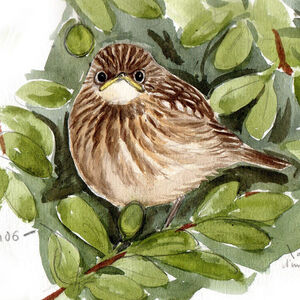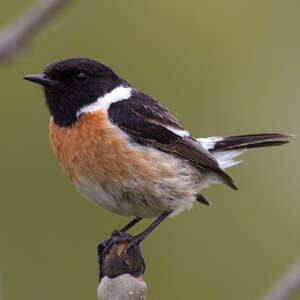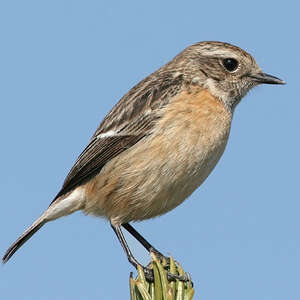European Stonechat
Saxicola rubicola - Tarier pâtre
Identification
The European Stonechat was formerly named the Whinchat. The new name may be confusing for old-timers. The adult male in breeding plumage is easy to identify due to its tricolour plumage, black, white and rufous. The head is almost like wearing a black hood that includes a black eye, bordered with two large white stripes forming a collar. The thin beak is also black. The mantle, back and wing covers are practically black after wear of the feathers at the end of the breeding season. At an earlier stage, these latter are fringed rufous, lightening the upper part. White is usually visible in the wing at the level of the internal middle covers. The rump and the upper-tail coverts are very pale, sometimes white. The flight feathers and the rectrices are black with rufous edges. The chest is light rufous-brown, and the rufous extends laterally on the flanks. The abdomen and lower tail coverts are white. The legs are blackish and the two subspecies, rubicola and hibernans, differ insignificantly. The adult female resembles the male, but she is much duller and with the plumage pattern blurred. The plumage is medium brown on the top and rufous underneath. A eyebrow and a reminiscence of the collar, both whitish, are sketched on the head. The throat is often spotted dark. The mantle is striped brown and rufous. The white spot on the wing is present. The lower parts are rufous except for the white lower-tail coverts. The rufous is also more intense on the chest. Some slight dark streaks can sometimes be seen. The juvenile is unmistakable. It looks like the female, but its plumage is dotted on the top and the bottom, a character of a muscicapid. The top parts are spotted beige-rufous, and the lower parts brownish-rufous.This characteristic quickly fades away through wear and tear during the summer.
Subspecific information 2 subspecies
- Saxicola rubicola rubicola (w, c and s Europe, nw Africa and Turkey to the Caucasus)
- Saxicola rubicola hibernans (Ireland, Britain, w France and Portugal)
Foreign names
- Tarier pâtre,
- Tarabilla europea,
- cartaxo-europeu,
- Schwarzkehlchen,
- cigánycsuk,
- Roodborsttapuit,
- Saltimpalo,
- svarthakad buskskvätta,
- Svartstrupe,
- pŕhľaviar čiernohlavý,
- bramborníček černohlavý,
- Vestlig Sortstrubet Bynkefugl,
- mustapäätasku,
- bitxac comú,
- Hagaskvetta,
- kląskawka (zwyczajna),
- tumšā čakstīte,
- prosnik,
- Западный черноголовый чекан,
- ヨーロッパノビタキ,
- 欧石䳭,
- svarthakad buskskvätta,
- 黑喉鴝〔黑喉石鵖〕,
Voice song and call
Its song is a short phrase made up of fairly grating-sounding notes. The tone is a bit monotonous. It is reminiscent of the Grey Wagtail's song, though shorter and less elaborate. The call is a sit tjek tjek with the last two syllables slightly muffled, which can be broken down into isolated sits, abbreviated to sit tjek or individual tjek (or tjak)s. In any case, it is a very characteristic call for the European Stonechat.
Habitat
The European Stonechat is a bird of open and semi-open habitats, cultivated or not and with a minimum of woody elements, but not too much.
Behaviour character trait
Many European Stonechats are sedentary due to a mild climate and live in pairs throughout the year, jointly defending their territory, especially in the warm season.
Others are forced to migrate for climatic reasons and in this case, the pairs separate and may only find each other the following spring on their own land. The European Stonechat isn't a sociable bird at all. The largest groups observed during the warm season are family groups before the emancipation of young ones. There may be a certain cohabitation in winter in particularly suitable areas, but one cannot talk of consistent and coordinated groups.Flight
The European Stonechat is a sedentary bird, so it doesn't need a rapid flight that its short, rounded wings prevent in any case. In its local movements, it has a slightly jumping flight, sometimes fluttering when it flies over its territory. It willingly practices hovering to inspect its environment and detect its prey. As with all muscicapids, the wings do not beat continuously but in sequences, hence the undulating flight.
Dietfeeding habits
The European Stonechat is almost exclusively insectivore. It captures all types of small to medium-sized invertebrates, mainly insects (beetles, flies, Lepidoptera, etc.
but also other arthropods (arachnids, myriapods, terrestrial crustaceans, etc.), small molluscs, small worms, a small lizard on occasion, etc. It hunts from a dominant post, shrub, stake, pole, wire, pile of wood or stones, etc. It also hunts on the spot by hovering with return to the initial perch or to another. The plant part of the diet is minimal. It occasionally consumes a few small seeds and some berries such as those of Rubus.Reproduction nesting
The European Stonechat is monogamous and territorial. The breeding season runs from March to August and starts early due to the species' sedentary nature.
From April to July, couples have enough time to raise two successive clutches, but this is not the case for birds in high altitudes or colder environments. The season starts with pariade, i.e. the formation or reformation of couples, which begins as early as March. The male repels its rivals with its voice and by demonstrating aggression with the pursuit of intruders. To attract a female, it emits its brief and monotonous song, usually from a high perch. It can also perform a brief nuptial flight up to 20 metres, calling in the meantime. It can also approach a female by performing hovering flight over her while singing, or by walking up to her in paradis. The female builds her nest on the ground or at a short height, under a clump of grass or at the foot of a dense small bush. The nest is a bulky but succinct heap of grass and dry leaves, with an inner cup lined with hair, sheep wool, feathers and other soft elements. A small tunnel in the vegetation often provides access. The female lays 5-6 pale blue eggs finely speckled with brown-red. The female incubates alone for 14-15 days, then takes care of the young ones in the first days. Later, both adults feed them in the nest for 15 days and up to 4 or 5 days after taking off. Afterwards, the female moves away to build a nest for the next clutch, while the male continues to feed the young ones for 5 to 10 additional days. This may be repeated for a possible third clutch.Geographic range
The European Stonechat breeds from the British Isles, France, Spain and the Maghreb to the west, to northern Turkey, the Caucasus and the Don region in Russia to the east, in a continuous range including the Black Sea. The ssp. hibernans breeds in Ireland, Great Britain, Brittany and the western coast of Spain. The majority of the birds are resident, but some are partial migrants (Irish birds, birds from the higher altitudes).
Threats - protection
Sources of information
- IOC World Bird List (v15.1), Gill, F and D Donsker (Eds). 2025-12-07.
- Les passereaux d'Europe, tome 2, P. Géroudet, M. Cuisin
- Birds of the World, The Cornell Lab of Ornithology
- xeno-canto, Sharing bird sounds from around the world,
Other sources of interest
 Specification sheet created on
17/07/2023 by Jean François
Specification sheet created on
17/07/2023 by Jean FrançoisTranslation by AI Oiseaux.net
© 1996-2025 Oiseaux.net
- Accipitriformes
- Aegotheliformes
- Anseriformes
- Apodiformes
- Apterygiformes
- Bucerotiformes
- Caprimulgiformes
- Cariamiformes
- Casuariiformes
- Charadriiformes
- Ciconiiformes
- Coliiformes
- Columbiformes
- Coraciiformes
- Cuculiformes
- Eurypygiformes
- Falconiformes
- Galliformes
- Gaviiformes
- Gruiformes
- Leptosomiformes
- Mesitornithiformes
- Musophagiformes
- Nyctibiiformes
- Opisthocomiformes
- Otidiformes
- Passeriformes
- Pelecaniformes
- Phaethontiformes
- Phoenicopteriformes
- Piciformes
- Podargiformes
- Podicipediformes
- Procellariiformes
- Psittaciformes
- Pterocliformes
- Rheiformes
- Sphenisciformes
- Steatornithiformes
- Strigiformes
- Struthioniformes
- Suliformes
- Tinamiformes
- Trogoniformes


































